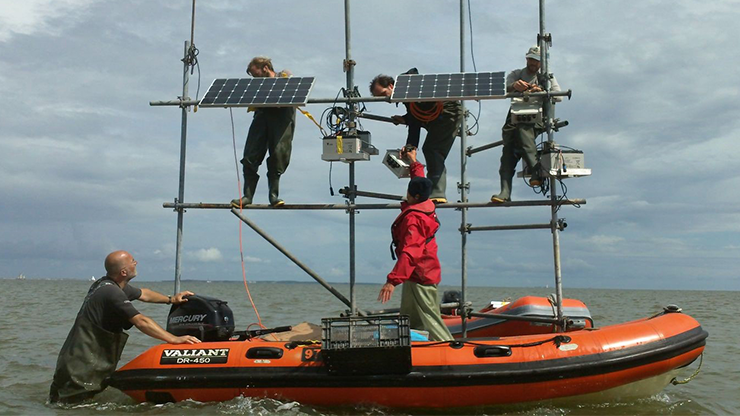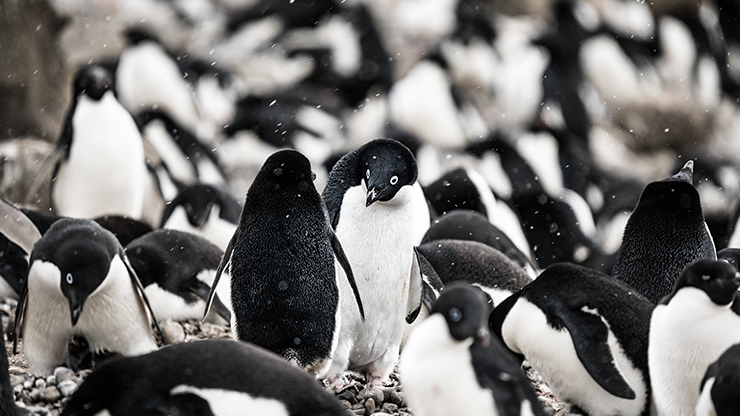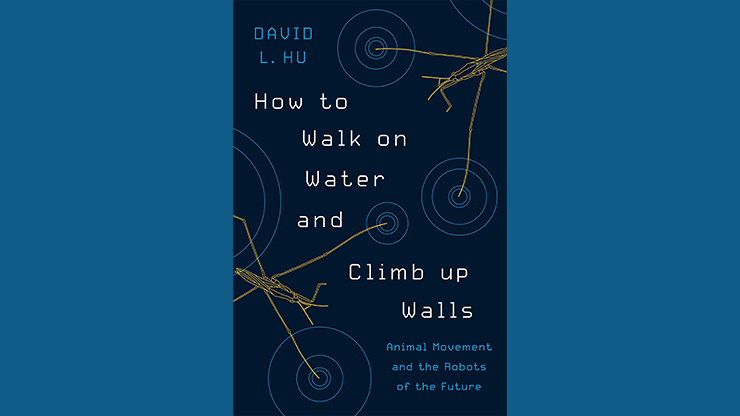Mathematical Models of Huddling Behavior in Animals Reveal Distinct Movement Patterns
Many animal species huddle together for warmth, including penguins and rodent pups. When engaging in huddling behavior, individuals continuously cycle their positions — rotating in and out of the center so that all agents have equal access to warmer temperatures. “Animals evolved to behave in a way that appears equitable to humans, even though biological principles tell us that they evolved to maximize their own reproductive value,” Nicole Zalewski of Temple University said.
Despite these shared tendencies, different species exhibit different dynamics. During a contributed presentation at the Third Joint SIAM/CAIMS Annual Meetings, which are currently taking place in Montréal, Québec, Canada, Zalewski compared two distinct mathematical models of huddling that ultimately yield similar milling behavior. “We want models that capture physics-inspired behavior in a structurally simple way,” she said. She thus modeled individual agents in a two-dimensional simplification of reality with first-order dynamics, using known attraction/repulsion forces coupled with exposure to cold.

The first part of Zalewski’s presentation focused on penguins, which huddle to protect themselves from wind, storms, and other harsh weather conditions (see Figure 1). During an ice storm, for instance, strong winds can push huddles up to 200 meters. When forming a huddle, the birds move in a spiral-like fashion towards the center. Exposed rear-flank agents advance slowly along the side of the huddle before eventually reaching the center, while those that begin in the center become members of the rear flank before gradually moving up the sides and repeating the cycle.
To understand this movement, Zalewski uses a first-order dynamics model wherein each agent moves in the direction of the wind with a strength that is proportional to their level of protection by other agents. In her model, \(P_i\) represents wind exposure and each agent is a circle around \(x_i\) that represents the body of the penguins. “Each penguin provides protection for other agents, so we model it as a rectangular that points in the direction of the wind,” Zalewski said. “Then, \(P_i\) is the percent of the body of agent \(i\) that is not contained in other rectangles.” Her resulting simulation with 50 agents—admittedly far fewer penguins than a real colony—effectively captured the qualitative behavior.
Next, Zalewski turned to rodent pups, whose huddling behavior is much different than their feathered counterparts. Pups huddle for warmth immediately after they are born, burrowing downward into the insulated center and displacing others to the periphery (see Figure 2). “In contrast to penguins, movement is driven by ambient temperature rather than wind,” Zalewski said. “And movement is towards the center rather than around the periphery.” Because newborn pups are too small to thermally regulate on their own, her rodent model includes coupling with agent coldness rather than wind exposure.

The resulting temperature model must account for agents’ own heat production and their interactions with other agents. While physics affirms that the amount of heat loss should be proportional to the exposed surface area, Zalewski desired a model that was less complicated than solving a partial differential equation at each time step. “We don’t need the entire heat field, we just want approximate heat loss,” she said. “We can do approximations on the solution to obtain simple expressions in terms of the geometry for heat loss.”
As such, Zalewski employs a basic model for which coldness changes over time as a function of the number of agents. “The model is structurally very simple, but it captures the geometry that we want,” she said. “Agents that are more surrounded experience less heat loss.” Zalewski utilized a term that represents altruistic/equitable behavior to couple motion with coldness. Here, \(\alpha\) is an “equality” parameter, \(\beta\) is an “equity” parameter, and \(\gamma=\beta/\alpha\) is the relative strength of altruism.
Zalewski once again modeled 50 agents as points, removing “pups” that die after expending too much energy in the absence of warmth. She then explored various levels of equity, including its absence. “Will increasing equitable behavior benefit the system as a whole?” Zalewski asked. “In reality, there is some motivation for agents to behave altruistically, so what happens if they don’t move?” Unsurprisingly, a complete lack of equity—where coldness has no impact on mobility—results in the eventual death of all agents. A balanced level of equity has some impact on push strength towards the center of the huddle, causing no death and moderate motion, while a high level of equity—where agents are maximally willing to yield their center position to those with a higher need—produces no death and lots of movement.
“When agents move based on coldness, we see milling behavior and a push towards the center,” Zalewski said. “Pups in the center of the huddle really do need to be willing to yield their position in the huddle. If animals do not yield their position, the entire species will suffer.” She determined that comparable access to warmth without the expenditure of too much energy is the optimal solution.
To conclude, Zalewski reiterated the value of structurally simple models—inspired by physical realities—that represent complex huddling behaviors and accurately replicate real observed dynamics. She noted that despite their different motivations, both penguins and rodent pups display a milling motion that continuously cycles group members in and out of the center. “Agents may evolve to have this behavior to benefit the whole group, even at a cost to individuals,” Zalewski said.
About the Author
Lina Sorg
Managing editor, SIAM News
Lina Sorg is the managing editor of SIAM News.

Related Reading
Stay Up-to-Date with Email Alerts
Sign up for our monthly newsletter and emails about other topics of your choosing.






